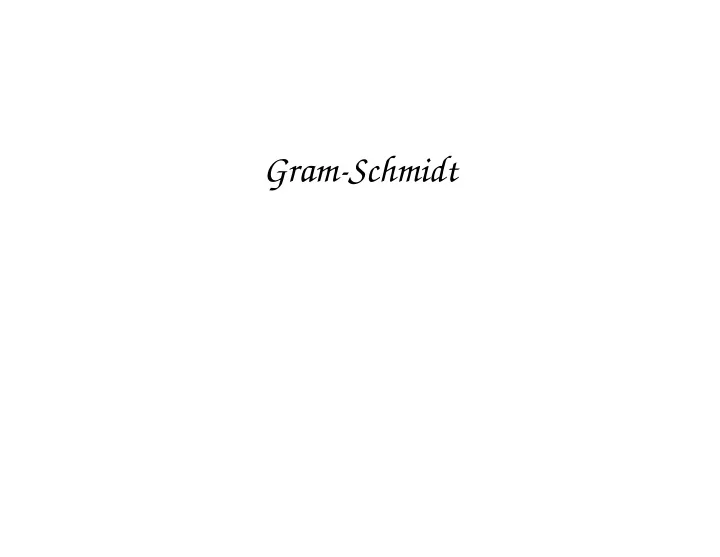

Gram-Schmidt
Finding Orthonormal Basis The famous Gram-Schmidt process is used to produce an orthogonal basis from a given ba- sis. It provides a constructive proof of the earlier claim that every vector space has an orthonor- mal basis. orthoFOUR: 2
Gram-Schmidt ALGOR Input: collection x 1 , . . . , x k of linearly independent vectors. Output: collection y 1 , . . . , y k of orthogonal vec- tors that span the same space. Process: Generate vectors y 1 , y 2 , y 3 , . . . by i − 1 � y i = x i − proj y j ( x i ) j =1 These vectors can then be normalized, if de- sired. orthoFOUR: 3
Example 1 2 3 Find orthonormal 1 0 1 basis of span x 1 = x 2 = x 3 = 0 − 1 1 of the vectors 0 3 − 7 Answer is: 1 1 8 / 3 1 − 1 − 8 / 3 y 2 = x 2 − 2 y 3 = x 3 − 4 2 y 1 − − 20 y 1 = 2 y 1 = 12 y 2 = 0 − 1 − 2 / 3 0 3 − 2 orthoFOUR: 4
Example Continued After normalization we have the vectors 1 1 1 2 (1 , 1 , 0 , 0) , 12 (1 , − 1 , − 1 , 3) , and 42 (4 , − 4 , − 1 , − 3) √ √ √ orthoFOUR: 5
Another Example Use Gram-Schmidt to find an orthogonal basis for the space spanned by (1 , 1 , 0) , (1 , 0 , 1) , and (0 , 1 , 2) . We proceed. 1 1 1 1 2 − 1 − 1 y 1 = y 2 = = 1 then 0 1 2 2 0 1 0 1 orthoFOUR: 6
Another Example Continued And 1 0 1 − 1 2 − 1 − 3 / 2 − 1 y 3 = = 1 1 1 2 2 3 / 2 2 0 1 1 Normalized, we have 1 1 − 1 1 1 1 , , 1 − 1 1 √ √ √ 2 6 3 0 2 1 (But note span of the vectors is all of R 3 ) orthoFOUR: 7
Summary The Gram-Schmidt process produces an orthog- onal basis. It considers the basis vectors in turn and for each, subtracts its projection onto the previous basis vectors. The resultant basis can be made orthonormal by normalization. orthoFOUR: 8
Recommend
More recommend